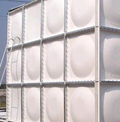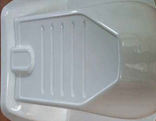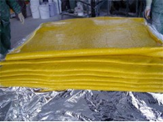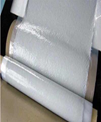The SMC material molding process is the most efficient one in the glass fiber reinforced plastic/composite material molding process. The SMC molding process has many advantages, such as: accurate product size, smooth surface, good product appearance and size repeatability, complex structure can also be molded at one time, secondary processing does not need to damage the product, etc. However, bad defects will also appear in the SMC molding production process, which are mainly manifested in the following reasons:




(I) Lack of material: Lack of material means that the SMC molded parts are not completely filled, and the production sites are mostly concentrated on the edges of the SMC products, especially the roots and tops of the corners.
(a) Less material discharge
(b) SMC material has poor fluidity
(C) Insufficient equipment pressure
(d) Curing too fast
Generation mechanism and countermeasures:
①After the SMC material is plasticized by heat, the melt viscosity is large. Before the cross-linking and solidification reaction is completed, there is not enough time, pressure, and volume to fill the mold cavity with the melt.
②) The storage time of the SMC molding material is too long, and the styrene volatilizes too much, resulting in a significant decrease in the flow properties of the SMC molding material.
③The resin paste is not soaked into the fiber. The resin paste cannot drive the fiber to flow during molding, resulting in material shortage. For the shortage of materials caused by the above reasons, the most direct solution is to remove these molded materials when cutting materials.
④Insufficient feeding amount causes material shortage. The solution is to increase the feeding amount appropriately.
⑤There is too much air and a lot of volatile matter in the molding material. The solution is to appropriately increase the number of exhausts; appropriately increase the feeding area and burp for a certain period of time to clean the mold; appropriately increase the molding pressure.
⑥The pressure is too late, and the molded material has completed cross-linking and curing before filling the mold cavity. ⑦If the mold temperature is too high, the cross-linking and curing reaction will advance, so the temperature should be appropriately lowered.

(2) Stoma. There are regular or irregular small holes on the surface of the product, most of which are produced at the top and middle thin walls of the product.
Generation mechanism and countermeasures:
①The SMC molding material contains a large amount of air and the volatile content is large, and the exhaust is not smooth; the thickening effect of the SMC material is not good, and the gas cannot be effectively driven out. The above causes can be effectively controlled by a combination of increasing the number of vents and cleaning the mold.
②The feeding area is too large, appropriately reducing the feeding area can be controlled. In the actual operation process, human factors may also cause trachoma. For example, if the pressurization is too early, it may be difficult for the gas wrapped in the molding compound to be discharged, resulting in surface defects such as pores on the surface of the product.
(3) Warpage and deformation. The main reason is the uneven curing of the molding compound and the shrinkage of the product after demolding.
Generation mechanism and countermeasures:
During the curing reaction of the resin, the chemical structure changes, causing volume shrinkage. The uniformity of the curing makes the product tend to warp to the first cured side. Secondly, the thermal expansion coefficient of the product is larger than that of the steel mold. When the product is cooled, its one-way shrinkage rate is greater than the one-way heat shrinkage rate of the mold. To this end, the following methods are adopted to solve the problem:
①Reduce the temperature difference between the upper and lower molds, and make the temperature distribution as even as possible;
②Use cooling fixtures to limit deformation;
③Appropriately increase the molding pressure, increase the structural compactness of the product, and reduce the shrinkage rate of the product;
④ Prolong the heat preservation time appropriately to eliminate internal stress.
⑤Adjust the curing shrinkage rate of SMC material.
(4) Blistering. The semicircular bulge on the surface of the cured product.
Generation mechanism and countermeasures:
It may be that the material is incompletely cured, the local temperature is too high, or the volatile content in the material is large, and the air traps between the sheets, which makes the semicircular bulge on the surface of the product.
(①When increasing the molding pressure
(②Extend the heat preservation time
(③) Lower the mold temperature.
④Reduce the unwinding area
(5) The surface color of the product is uneven
Generation mechanism and countermeasures:
①The mold temperature is not uniform, and the part is too high. The mold temperature should be properly controlled;
②Poor fluidity of the molding material, resulting in uneven fiber distribution, generally can increase the molding pressure to increase the fluidity of the melt;
③Pigment and resin can’t be mixed well in the process of color paste blending.
Post time: May-04-2021






